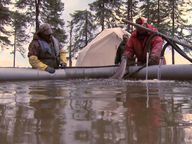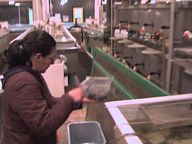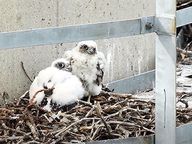The generation and transmission of electricity involves extensive use of land resources to provide sites and materials for facilities and activities. Use of these resources can produce a variety of associated effects, ranging from the contamination of soils to the creation or reduction of wildlife habitat.
When construction crews build transmission lines and generation projects they are guided by environmental protections plans developed specifically for the project.
The plans use an atlas of maps to describe environmental conditions along the construction routes, identify sensitive features, and prescribe environmental protection activities for specific sites and circumstances.
Environmental protection plans now apply to all major projects, including guidelines for protecting the environment during construction, maintenance, and decommissioning.
Learn more about Fur, Feathers, Fins and Transmission Lines: How transmission lines and rights-of-way affect wildlife (PDF, 7 MB).
Fisheries and stewardship
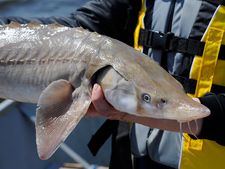
Lake Sturgeon are the largest freshwater fish in Manitoba and protected through limited fishing.
Lake Sturgeon Stewardship & Enhancement Program
We initiated the Lake Sturgeon Stewardship & Enhancement Program as a commitment to maintain and enhance Lake Sturgeon populations in areas affected by our operations.
- Annual Report 2021 (PDF, 2.8 MB)
- Annual Report 2020 (PDF, 659 KB)
Our report, Lake Sturgeon in Manitoba – A Summary of Current Knowledge (PDF, 2.5 MB), summarizes what is known about Lake Sturgeon, such as the most recent population and ecology information.
The program contributes to the recovery of Lake Sturgeon in Manitoba by:
- determining Lake Sturgeon population status throughout areas affected by our operations, and identifying factors that may be limiting the populations:
- completing inventories of Lake Sturgeon populations;
- assessing the habitat available in the Winnipeg and Nelson rivers.
- funding and conducting Lake Sturgeon research in Manitoba and at hydroelectric facilities:
- using genetics to examine current and historical Lake Sturgeon population structure:
- improving methods for culturing Lake Sturgeon for conservation purposes, including research on pathogens;
- collaboration with the provincial government on research priorities:
- MOU Annual Report 2015/2016 (PDF, 263 KB).
- minimizing the effects of facilities on Lake Sturgeon populations:
- investigating opportunities to minimize the effects of new facilities;
- reviewing existing facilities and investigating opportunities to reduce effects of existing facilities.
- participating in the management and recovery of existing stocks by promoting education and community participation through sturgeon management boards:
- Nelson River Sturgeon Board;
- Saskatchewan River Sturgeon Management Board.
- Kischi Sipi Namao Committee (KSNC, formerly Lower Nelson River Sturgeon Committee)
- KSNC 2016–2018 Summary Report (PDF, 1.2 MB).
- educating the public and raising awareness:
- working with government, First Nations, and other stakeholders to increase awareness about the sensitivity and importance of Lake Sturgeon.
Grand Rapids Fish Hatchery
The Grand Rapids Fish Hatchery became a part of Manitoba Hydro in 2007. The Hatchery strives to contribute to fish recovery efforts, facilitate research, and educate the public. Our facility includes a research centre and visitor centre, and is currently undergoing upgrades to increase capacity.
Every year, Grand Rapids Fish Hatchery coordinates with other stakeholders to collect fish eggs in northern Manitoba between late May and early June. The Hatchery rears 2 species of fish: walleye and sturgeon.
Walleye eggs are received and incubated from the spawn collection camp at Vermillion River near Southern Indian Lake and from the Saskatchewan River. Walleye fry are later stocked back into the populations they were collected from in support of fisheries in those areas.
As part of our Lake Sturgeon Stewardship & Enhancement Program, Lake Sturgeon eggs are collected from the Nelson and Burntwood rivers and brought back to the Hatchery for grow-out. These sturgeon are then stocked as larvae, fingerlings, or yearlings into their native waterways to support populations in the area.
Sturgeon Management
The Nelson River Sturgeon Board actively manages the sturgeon population through activities such as tagging the fish and recording data on age, length, & weight, and collecting spawn for breeding and re-stocking. Manitoba Hydro participates on the Nelson River Sturgeon Board with the provincial government, 4 Northern Affairs communities, and 3 First Nations communities.
Sturgeon Conservation Aquaculture
Each spring, the Nelson River Sturgeon Board collects eggs from adult sturgeon in the Nelson River and sends them to the Grand Rapids Fish Hatchery for grow-out. Some sturgeon are also raised at a stream-side hatchery at Jenpeg which is run by the Board. Lake Sturgeon are stocked as larvae, fingerlings and yearlings at various locations along the upper Nelson River.
Moose
Moose are the largest member of the deer family and are an important component of Manitoba’s natural environment. In recent years, moose populations have shown signs of decline in portions of Manitoba. To help understand these changes, we have 2 new funding programs aimed at investigating, enhancing, and sustaining moose populations in Manitoba. These programs were developed with Manitoba Agriculture and Resource Development and will complement an existing multi-year moose monitoring program that is aimed at understanding the effects of the Bipole III transmission project.
The Moose Stewardship Study Program
The Moose Stewardship Study Program is now complete. Thank you to all who applied.
The Moose Stewardship Conservation Program
The Moose Stewardship Conservation Program is now complete. Thank you to all who applied.
2022 successful applicants
- Moose Stewardship Study Program:
- University of Manitoba – Using metabarcoding to estimate moose diet, ingestion of gastropods, and parasitism.
2021 successful applicants
- Moose Stewardship Conservation Program:
- Assiniboine Park Conservancy and Brokenhead Ojibway First Nation – Communicating Science and Knowledge to and from Communities;
- Black River First Nation – The Black River First Nation Moose Monitoring and Tracking Project;
- Misipawistik Cree Nation – Misipawistik Cree Nation kanawenihcikew Guardians Moose Monitoring Program;
- Opaskwayak Cree Nation – Moose Monitoring Project.
- Moose Stewardship Study Program:
- University of Manitoba – Parasite risks to moose: Comparing the role of gastropod intermediate hosts in parasite transmission in eastern and western Manitoba.
2020 successful applicants
- Moose Stewardship Conservation Program:
- No applicants due to pandemic.
- Moose Stewardship Study Program:
- University of Manitoba – Parasite risks to moose: Investigating the role of gastropod intermediate hosts in transmission in Western Manitoba.
2019 successful applicants
- Moose Stewardship Conservation Program:
- Black River First Nation – The Black River First Nation Moose Monitoring and Tracking Project;
- Manitoba Wildlife Federation – Education, Training and Outreach – Promoting Moose Conservation in First Nation Communities;
- Misipawistik Cree Nation – The Misipawistik Cree Nation kanawenihcikew Guardians Moose Monitoring Program.
- Moose Stewardship Study Program:
- Memorial University – Human Dimensions in Moose Management in Manitoba;
- University of Manitoba – Factors affecting the health of moose populations in western Manitoba.
2018 successful applicants
- Moose Stewardship Conservation Program:
- Black River First Nation – The Black River First Nation Moose Monitoring and Tracking Project;
- Opaskwayak Cree Nation – The Opaskwayak Cree Nation Moose Stewardship Conservation Program 2018 Project;
- University of Saskatchewan – Engaging and Educating Manitoba Youth as Stewards of Moose in Manitoba.
- Moose Stewardship Study Program:
- Memorial University – Disentangling the Effects of Local and Regional Factors that Promote Occupancy and Abundance of Moose.
Application deadline
Applications must be submitted by May 31, 2022.
Contact us early in your application development process as we may be able to help you with your proposal by identifying opportunities with other organizations to develop collaborative, multi-component and co-funded projects.
- Mail:
Manitoba Hydro
Moose Stewardship Programs
360 Portage Avenue
Winnipeg, MB
Canada R3C 0G8 - Phone toll-free 1-877-343-1631
- Email the Moose Stewardship Program
Peregrine falcons
Peregrine Falcons at Selkirk Generating Station 2020
A pair of peregrine falcons returned to Selkirk generating station in summer 2020 before heading back to their wintering grounds in the USA and Mexico. We work with the Peregrine Falcon Recovery Project to keep the birds safe.
We monitor the impact our projects and equipment have on peregrine falcons to help protect the species at risk.
One of the tallest buildings in the Selkirk area is Selkirk generating station. Its high location near water has made it the nesting spot of choice for a pair of peregrines falcons. For several years the birds have nested at the generating station after their long migration from their wintering grounds in the southern USA and Mexico. We’ve worked with the Peregrine Falcon Recovery Project to protect them.
Woodland caribou
We support research on woodland caribou populations, some of which are located near the Wuskwatim generating station and its associated transmission lines. The research is designed to shed light on caribou behaviour and could help plan and design future generation and transmission developments.
As part of the research, DNA is extracted from fecal material to identify individual animals and to help determine population structure, size, and trends. This information is essential to assessing and mitigating the impact of industrial activities on the species.
In other research, biologists are collecting data on the whereabouts of the herds through aerial surveys that use Very High Frequency and Global Positioning System tracking collars worn by the animals. When interpreted, data from the collars show where the caribou have gone, yielding insights into their habitat requirements, migration patterns, and other life-cycle characteristics, as well as the potential effects of resource development.
Woodland caribou in the province are widely dispersed, from the Manitoba-Ontario border, east of Pine Falls, to Lynn Lake. Caribou live in the boreal forest and use a variety of habitats including mature spruce, jack pine, and treed bog. Their main source of food is lichen, but they may also eat twigs, leaves and sedges.
Zebra mussels
Treatment schedule
In 2024, low-level chlorine treatment is planned at the Kelsey, Kettle, Longspruce, Limestone and Jenpeg generation stations. Treatment is also planned for the Grand Rapid Generating Station.
In 2023, the second year of treatment, low-level chlorine treatment occurred at the Grand Rapids, Keeyask, Kelsey, Kettle, Longspruce, Limestone and Jenpeg generation stations.

Tiny zebra mussels are an invasive aquatic species.
Enlarge image: Zebra mussel next to a dime on a person’s hand.
Zebra mussels are an invasive aquatic species native to Europe. Zebra mussels were introduced to North America in the late 1980s through cargo shipping. They were first detected in Lake Erie. In a few years they had spread into the rest of the Great Lakes. Since then, zebra mussels have spread to Manitoba.
They were first detected in the Lake Winnipeg south basin in 2013 and have now spread downstream. In fall 2019, zebra mussel larvae (veligers) were found in the Nelson River up to the Limestone generating station near Gillam.
Without treatment, zebra mussels pose a significant risk to the safe operation of generating stations. Zebra mussels can grow inside pipes, reducing or blocking water flow to critical systems for unit cooling and fire protection.
Controlling zebra mussels within our facilities
Zebra mussel growth in critical generating station pipes can be controlled using a low-level chlorine treatment. Chlorine treatment is the most effective method to control adult zebra mussel growth and is widely used at other hydroelectric generating stations in North America.
When needed, treatment is administered within generating station pipes when water temperatures are above 15°C. The treatment controls zebra mussel growth in essential pipes. The concentration of chlorine used in the treatment is similar to levels found in municipal drinking water.
Treatment is conducted by an experienced contractor for approximately 2 weeks per facility. The chlorinated water is de-chlorinated before it leaves the station.
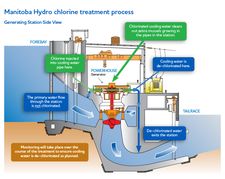
View a cross section of a typical generating station showing the chlorine treatment and monitoring process.
Treatment and aquatic life
No effect on fish or aquatic life is anticipated. The zebra mussel treatment targets pipes within the generating stations, and this water is de-chlorinated before it is discharged from the station. Monitoring takes place over the course of the treatment to ensure the treatment solution is de-chlorinated before it is discharged. Manitoba Hydro’s zebra mussel treatment plan was developed with the help of industry experts and has been approved by the Pest Management Regulatory Agency of Health Canada, Manitoba Environment, Climate and Parks (formerly Manitoba Conservation and Climate), and Manitoba Agriculture and Resource Development.
Zebra mussels: Five generating stations successfully treated
In fall 2019, our staff first detected zebra mussels near Limestone generating station. As of fall 2021, we’ve successfully treated 5 of our Nelson River generating stations for zebra mussels.
More information about zebra mussels can be found on the Province of Manitoba’s Stop Aquatic Invasive Species website.

